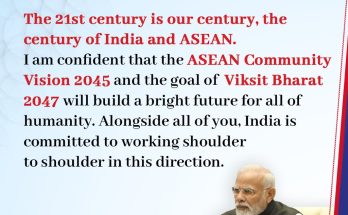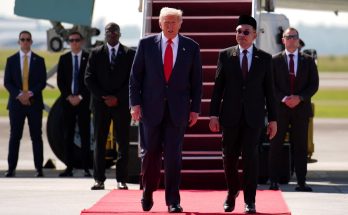 Call it the Modi tsunami or the strong desire of voters for a new political and development narrative in one of India’s most impoverished and caste-fragmented state of Uttar Pradesh. Either way, it is historic, as Mr Modi himself termed the spectacular show by India’s ruling Hindu nationalist Bharatiya Janata Party in legislative assembly elections in the key political battleground state of Uttar Pradesh.
Call it the Modi tsunami or the strong desire of voters for a new political and development narrative in one of India’s most impoverished and caste-fragmented state of Uttar Pradesh. Either way, it is historic, as Mr Modi himself termed the spectacular show by India’s ruling Hindu nationalist Bharatiya Janata Party in legislative assembly elections in the key political battleground state of Uttar Pradesh.
More than anything else, it reflects a huge consolidation of votes cutting across caste and religion affiliations. The BJP and its minor allies have won 312 of 403 state legislative assembly seats — a stunning mandate that even BJP chief Amit Shah acknowledged was “unexpected.”
The result mirrors the 2014 parliamentary poll battle when the BJP won 73 of the 80 Lok Sabha seats in UP. If analysts today are talking about a ‘Modi win’ rather than ‘BJP win’ in the state, there is a reason for this. Two and half years ago, it was Modi and Modi alone on whom the BJP had relied on heavily to sail through and the same was repeated in the assembly elections this time. Unlike its rivals, the BJP went to the poll in UP without projecting a chief ministerial candidate simply because none has the charisma or vote-catching ability of Modi.
Shah’s poll maths
A major part of the credit for BJP’s success in UP goes to Shah who crafted the election strategy of building a broad coalition of castes in UP. Interestingly, the party did not field a single Muslim candidate in the just-concluded elections in UP where Muslims have a sizable presence.
 Mr Shah appointed BJP veteran Kesav Prasad Maurya as the head of the party’s state unit and inducted Swami Prasad Maurya who defected from Bahujan Samaj Party as part of efforts to changing the caste arithmetic which, along with Muslim votes, has traditionally played a key role in shaping the electoral outcome in the state. BJP’s attempts were aimed at reworking the caste and religious fault lines. It took care not to antagonize any particular caste. In fact, the UP election was projected by Shah as a battle among SP’s Muslim-Yadav (a backward caste) support base and BSP’s Jatavs (the lowest rung in caste hierarchy) vs other Dalits which were supposed to vote for the saffron party.
Mr Shah appointed BJP veteran Kesav Prasad Maurya as the head of the party’s state unit and inducted Swami Prasad Maurya who defected from Bahujan Samaj Party as part of efforts to changing the caste arithmetic which, along with Muslim votes, has traditionally played a key role in shaping the electoral outcome in the state. BJP’s attempts were aimed at reworking the caste and religious fault lines. It took care not to antagonize any particular caste. In fact, the UP election was projected by Shah as a battle among SP’s Muslim-Yadav (a backward caste) support base and BSP’s Jatavs (the lowest rung in caste hierarchy) vs other Dalits which were supposed to vote for the saffron party.
Accordingly, BJP allocated around 150 seats to non-Yadav Other Backward Caste candidates in UP. This, along with its tie-ups with sub-regional parties like Apna Dal and Suheldev Bharatiya Samaj Party (SBSP) helped it consolidate non-Yadav backward caste groups like Patels, Kurmis and Rajbhars.
All political parties in UP resorted in some degree to attempts to polarise voters: SP and BSP sought to woo Muslim voters by asking them to vote “en bloc” for them. The BSP fielded nearly 100 Muslim candidates and a key reason behind the SP’s alliance with Congress was to get maximum votes from the minority community. Responding to rivals’ strong push to win over Muslim votes, the BJP too played the Hindutva card during the campaign through Mr Modi’s reference to ‘Kabristan’ (graveyard) vs ‘Shamshan” (crematorium) remarks. Amit Shah coined “Kasab” – one of the terrorists who perpetrated the November 2008 terror attack in Mumbai – to denote Congress, SP and BSP as part of one alliance pitted against the BJP.
Secondly, a key feature of Mr Shah’s strategy for UP was that even as BJP depended heavily on Mr Modi’s image, it was careful to ensure that local leaders are given due weight during campaigning. This was a lesson that the party seemed to have learnt from its electoral debacle in the assembly poll in Bihar a few years ago.
At the same time, Mr Shah and BJP’s other poll managers did not fall back just on local leaders and made full use of Mr Modi’s charisma. The prime minister was initially supposed to address around 10 rallies but ultimately spoke at around 30 rallies. Mr Modi stayed put in his parliamentary constituency of Varanasi for nearly three days, something he didn’t do even during the Lok Sabha polls. Both showed the high stakes Mr Modi and BJP had in UP assembly elections, especially in eastern part of the state (including Varanasi) which has 133 assembly seats.
Thirdly, in choosing candidates for UP poll, the BJP appeared to believe that “at the end of the day it is the winnability of a candidate that matters.” The party welcomed in its fold candidates from other parties and it is estimated that about 100 seats were allocated to candidates who switched over from other parties because they were supposed to have better chances of winning than the BJP’s own candidates.
Thumbs-up for demonetisation
The elections in UP and the other states were the first major test of Modi’s popularity in the wake of the banning of high-denomination currency notes in November-December last year in a bid to cleanse the country’s financial from the menace of black money. The demonetization saw serpentine queues in front of banks and post offices as people rushed to return or exchange their old notes for several weeks.
Mr Modi called the massive demonetization drive, which withdrew 86 percent of the country’s currency bills from the system, to cleanse the system of tax evasion and corruption. There was a perception that ordinary people were angered for having to stand for long hours in queues in banks and post offices. The opposition parties campaigned aggressively against demonetization as bad for the economy and wanted to tap into the temporary inconvenience caused by scrapping of high-denomination currency notes. However, as the election results show, demonetisation got a ringing endorsement. That this was on the cards in UP was evident in civic polls which took place a few weeks earlier in Chandigarh and in states like Gujarat and Maharashtra and panchayat polls in Odisha state where the BJP emerged as hands-down winner. In fact, Mr Modi repeatedly hit back at the opposition’s criticism of note ban by painting them black on the issue of black money.
 Analysts said the poll results in UP, which is largely an agrarian state, showed Mr Modi had succeeded in tapping into popular anger over corruption and black money with the demonetization move in a country where most transactions are cash-based. Clearly, people were more struck by the act of Mr Modi itself than by its consequences. It was a move that went beyond party and caste and affected everyone equally, especially the rich.
Analysts said the poll results in UP, which is largely an agrarian state, showed Mr Modi had succeeded in tapping into popular anger over corruption and black money with the demonetization move in a country where most transactions are cash-based. Clearly, people were more struck by the act of Mr Modi itself than by its consequences. It was a move that went beyond party and caste and affected everyone equally, especially the rich.
Since taking office in May 2014, Mr Modi’s government has been pumping funds into boosting education, while increasing spending on roads, irrigation and other infrastructure. It has also been reforming India’s complicated tax regime. But the two biggest setbacks of his premiership came when the BJP was roundly beaten in elections for Delhi’s local assembly and the assembly in the eastern state of Bihar in 2015. The unprecedented victory in UP this time has put all that behind Mr Modi who will now seek to further tighten his grip on power.
Reacting to the victory, Mr Modi tweeted “Am overjoyed that BJP has received unprecedented support from all sections of society. Huge support from the youth is gladdening.” His cabinet colleague and Home Minister Mr Rajnath Singh said “BJP has reached new heights in Uttarakhand and Uttar Pradesh states and changed the political picture of the country.”
Overall, the BJP’s victory in UP signals a new kind of politics that go beyond traditional poll arithmetic. Mr Shah called the win in UP a “historic mandate” for BJP. “These results will set Indian politics in a new direction,” he said at a press conference at the party’s New Delhi headquarters, adding “the faith that people have placed in BJP and in Shri Narendra Modi will pay off.”
Author Profile
- India Writes Network (www.indiawrites.org) is an emerging think tank and a media-publishing company focused on international affairs & the India Story. Centre for Global India Insights is the research arm of India Writes Network. To subscribe to India and the World, write to editor@indiawrites.org. A venture of TGII Media Private Limited, a leading media, publishing and consultancy company, IWN has carved a niche for balanced and exhaustive reporting and analysis of international affairs. Eminent personalities, politicians, diplomats, authors, strategy gurus and news-makers have contributed to India Writes Network, as also “India and the World,” a magazine focused on global affairs.
Latest entries
 DiplomacyOctober 4, 2025UNGA Resolution 2758 Must Not Be Distorted, One-China Principle Brooks No Challenge
DiplomacyOctober 4, 2025UNGA Resolution 2758 Must Not Be Distorted, One-China Principle Brooks No Challenge India and the WorldJuly 26, 2025MPs, diplomats laud Operation Sindoor, call for national unity to combat Pakistan-sponsored terror
India and the WorldJuly 26, 2025MPs, diplomats laud Operation Sindoor, call for national unity to combat Pakistan-sponsored terror India and the WorldJuly 25, 2025When Fire Ends, Diplomacy Begins
India and the WorldJuly 25, 2025When Fire Ends, Diplomacy Begins India and the WorldJuly 16, 2025Operation Sindoor and its Aftermath: India’s Successful Diplomatic Outreach
India and the WorldJuly 16, 2025Operation Sindoor and its Aftermath: India’s Successful Diplomatic Outreach







